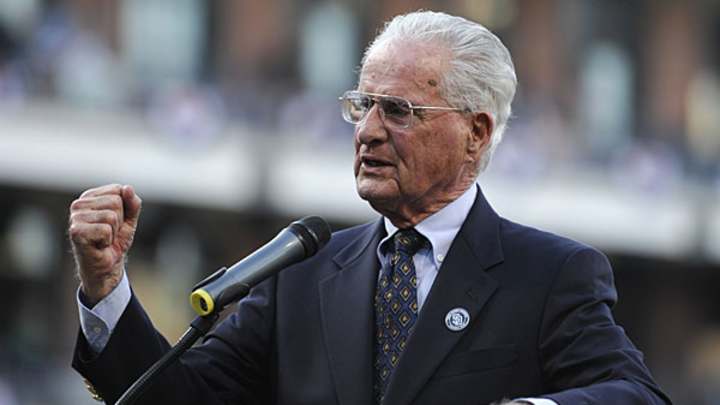Jerry Coleman, war hero and Hall of Fame broadcaster, dead at 89

Jerry Coleman, 1924-2014. (Dennis Poroy/Getty Images)

Baseball lost one of its great men on Sunday with the death of longtime Padres broadcaster Jerry Coleman, who died at the age of 89 after suffering head injuries in a recent fall. Coleman received the Hall of Fame's Ford C. Frick award in 2005 and is best known to today as the longtime radio voice of the San Diego Padres, but he was also a decorated Marine aviator who flew combat missions in both World War II and the Korean War. As a player, he was an All-Star second baseman and World Series hero for the great New York Yankees teams of the late 1940s and '50s.
Coleman was just 17 when the bombing of Pearl Harbor brought the United States into World War II, and though he wasn't yet of age, it immediately became his ambition to join the war effort as a pilot. He bided his time after graduating San Francisco's Lowell High School in June 1942 by playing in the D-level PONY league for the Yankees' Wellsville, N.Y., affiliate and enlisted immediately upon turning 18 that September. Ultimately stationed in the Philippines, Coleman flew 57 missions in close air support of General Douglas MacArthur's troops in 1944 and '45.
After the war, Coleman returned to the Yankees' farm system and worked his way up to become their starting second baseman in 1949, displacing war-time star Snuffy Stirnweiss. A slick defender with little power but considerable, and likely underappreciated, on-base skills, Coleman hit .282/.370/.370 in his first two seasons in New York, finishing third in the Rookie of the Year voting in 1949 (and winning the Associated Press' version of the award) and making the All-Star team in 1950.
In the final game of the 1949 regular season, Coleman delivered what proved to be the pennant-winning hit, a two-out, bases-loaded bloop into no-man's land near the foul line in Yankee Stadium's shallow rightfield that fell for a three-run double in a game the Yankees won 5-3 to eliminate the Red Sox and take the first of five consecutive pennants under new manager Casey Stengel. In 1950, Coleman received the Babe Ruth Award as the Most Valuable Player of the Yankees' four-game World Series sweep of the Whiz-Kid Phillies. Coleman hit .286/.375/.357 with two game-winning hits and sparkling defense in the Series.
Coleman was just barely 26 that fall, but his best days as a ballplayer were behind him. His hitting fell off in 1951 and he lost all but 17 games of the 1952 and '53 seasons to the Korean War. Eye problems led to his worst year at the plate in 1954, and a broken collarbone limited him to 43 games in 1955. By 1956, he was 31 and a part-time player. Still, he went out on a high note, starting all seven games of the 1957 World Series, hitting .364/.440/.455.
In Korea, Coleman flew 63 combat missions, becoming the only major leaguer to see combat in two wars. Over the course of his service, he received two Distinguished Flying Crosses, 13 Air Medals and three Navy Citations and ascended to the rank of Lieutenant Colonel. He continued to do promotional work for the Marines until retiring in 1964. Despite those accomplishments, Coleman prefered to be thought of as a "survivor" of two wars, rather than as a war hero.
That humility extended to his time in baseball, as well. He was embarrassed that his pennant-winning hit in 1949 was a cheap pop-up, a jam-shot off the trademark rather than the ringing double it appeared to be in the box score, and despite his strong hitting, he remembered his showing in the 1957 Series as a failure because the Yankees lost to the Braves in seven games. Coleman blamed his own failure to move a runner to third with no outs and the Yankees trailing 4-1 in the eighth inning of Game 4 for New York ultimately losing that game, 5-4, in 10 innings.
After the 1957 season, Coleman took a front-office job with the Yankees but didn't find satisfaction in his position and briefly went to work for the Van Heusen Shirt Company before finding his way back into the game as a broadcaster. Coleman's first broadcasting job was hosting a pre- and post-game show with Dizzy Dean and Pee Wee Reese for CBS's Game of the Week starting in 1960. In 1963, he began broadcasting Yankees' games for WCBS radio and WPIX television alongside all-time greats Mel Allen, Red Barber and his former double-play partner Phil Rizzuto. In 1970, he returned to his native west coast, broadcasting Angels games for two years before finally joining the Padres in 1972.
As a broadcaster, Coleman was known for his signature exclamations "Oh, Doctor," a phrase he picked up from Stengel, and "You can hang a star on that baby," as well as for his myriad misstatements, many of which may have been apocryphal. Nonetheless, he was a beloved and respected part of the Padres' organization and was even called upon to manage the team for one year. Coleman's 1980 Padres boasted three future Hall of Famers in Dave Winfield, Rollie Fingers (both in their final year in San Diego) and Ozzie Smith, but lacked the depth to compete and finished last in the National League West, 19 1/2 games behind the first-place Astros. In 1981, Coleman returned to the broadcast booth where he remained through the 2013 season. Altogether, he spent exactly 50 years calling major league baseball games and 62 of his 89 years in professional baseball in one capacity or another.
Here is Coleman's call of Mickey Mantle's 500th home run from May 1967. Mantle was just the sixth man to reach 500 home runs at the time:
Here is Coleman's call of Tony Gwynn's 3,000th hit from August 1999, which includes both of Coleman's signature phrases:
[mlbvideo id="20567989" width="600" height="360" /]
